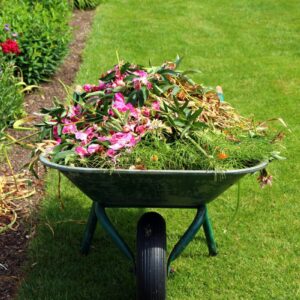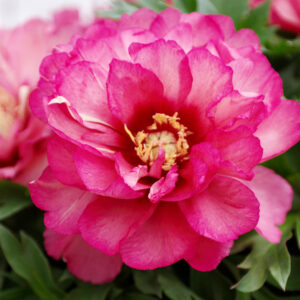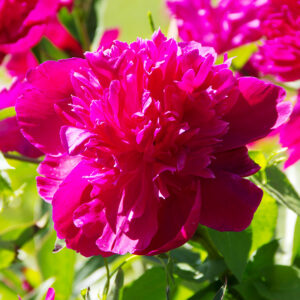Fall is an essential time in the world of peonies. Spring is when they put on their show of large and fragrant blooms. The actions taken in the fall can greatly impact the health and success of peonies in the spring. Whether you are planting bare-root peonies in the fall or caring for established plants how you plant and care for peonies in the fall makes a difference. Set yourself up for success by reading more about the care of peonies in the fall.
Planting Peonies in the Fall
Peonies are available for planting in both the spring and fall seasons. However, the best time to plant bare-root peonies is in the fall months. During the fall months, peonies are putting in the most root growth, and therefore, new plantings become stronger and healthier plants. The cool soil temperatures of the fall months provide optimal growing conditions for newly planted bare-root peonies.
Bare root peonies need to be planted 6 weeks before the ground freezes for winter. In colder climates zones 3-6 bare-root peonies should be planted between late September and mid-November. Warmer zones of hardiness zone 7 and 8 can plant bare-root peonies between October and December.
Peonies are sensitive to planting depth. If they are planted too deep they will fail to bloom or not grow. Therefore, bare-root peonies should be planted 1-2″ below the soil surface. Adding a light layer of natural wood mulch to the peony planting area will insulate and regulate the soil temperature and moisture level. For fall plantings, especially in colder climates adding mulch after planting is beneficial.
What kind of peonies can be planted in the fall?
Since fall is such a great time for planting peonies the choices of what kind to plant are plentiful. Herbaceous peonies are traditional types whose foliage dies back to the ground in the winter. Itoh peonies are exciting new hybrid peonies that are crossed between herbaceous peonies and tree peonies. They have stronger and more sturdy stems but retain the showy and fragrant blooms of herbaceous peonies. For more information on these two popular groups of peonies click here.
Fall Peony Care
Existing peony plants require and benefit from care in the fall months. After peonies are finished blooming in the spring their foliage remains in the garden and is often quite attractive. Peony leaves are dark green and luscious, therefore, making them a lovely backdrop for summer blooming perennials and annuals. However, peony leaves and stems are susceptible to airborne fungal leaf diseases. Powdery mildew and botrytis blight can both impact the health and appearance of peonies.
 Cleaning up diseased leaves in the fall will help prevent fungal leaf diseases the following year. In the fall clear, and discard all peony leaves, whether they are still on the plant or have fallen to the ground. If the leaves aren’t removed from the area, and fungal spores are present on the leaves; this makes the plants susceptible to the same fungal leaf diseases the following season.
Cleaning up diseased leaves in the fall will help prevent fungal leaf diseases the following year. In the fall clear, and discard all peony leaves, whether they are still on the plant or have fallen to the ground. If the leaves aren’t removed from the area, and fungal spores are present on the leaves; this makes the plants susceptible to the same fungal leaf diseases the following season.
Cut back herbaceous peonies all the way to the ground during the fall months. Their growth comes from the roots underground each season, therefore, cutting them back has no ill effect on the growth the next year. Itoh peonies can be treated in a similar way, by removing the soft, fleshy herbaceous stems and leaves in the fall. The base of Itoh peonies may feel more woody, and therefore, that portion of the plants can stay intact.
Powdery Mildew on Peonies
While powdery mildew will appear in the summer months you may not notice it until the fall cleanup. Powdery mildew is common on a slew of garden plants – roses and tall phlox are particularly susceptible, as well as peonies. It appears as a white coating on the leaves and stems, and has a powder-like appearance. It won’t kill your plants, however, it can weaken them, and make them vulnerable to other problems; also, it can be unsightly.
At the first signs of powdery mildew, remove any and all leaves and stems it appears on. Sterilize your pruners between cuts to prevent the spread of healthy stems and leaves. If it is too late to selectively remove the powdery mildew a fungicide can be applied. However, this works best if applied before the mildew is noticed. Therefore, preventative measures in future seasons are the best option for a bad case of powdery mildew.
To prevent powdery mildew on peonies, make sure the plants have adequate airflow. To increase the airflow selectively remove stems and leaves, so they are not as crowded. Don’t spray the leaves with water or use a sprinkler on them to water, watering at the base is best to prevent fungal leaf diseases. Cleaning up dead and diseased leaves in the fall is critical to preventing this fungal leaf disease.
Botrytis Blight on Peonies
The other common fungal leaf disease to appear on peonies is botrytis blight. It shows up as black tar-like spots on the leaves and stems. A very bad case of botrytis blight can disfigure and stunt the growth of newly emerging foliage. Similar to powdery mildew in that the best way to treat it is to prevent it. Once spots are seen it can be difficult to remove. If it is only appearing on a small amount of leaves and stems it can be removed by pruning, again, sterilize the pruner between cuts.
Prevention is the best way to avoid and prevent botrytis blight. In the fall when raking leaves and cleaning up the garden, remove peony leaves and stems when cutting the plants back. Discard the leaves away from your garden and yard, so any fungal spores that are present will not be able to spread. Clean up any leaves that are on the ground around the surface of the peonies. Being diligent about having a clean area for your peonies will help prevent the spread of botrytis blight and other fungal leaf diseases.
Prepare in the Fall for Gorgeous Peonies in Spring
Peonies can be planted right along with tulips, daffodils, and other fall bulbs. They perform and grow best when started in this cool weather season. Just remember to plant them in enough time before the ground freezes, and add some mulch for added protection.
For established plantings, be sure to take care of and clean the area when out in the yard for a fall clean-up. By preparing your peonies in the fall, your peonies will thank you in the spring with healthy foliage and large, robust blooms.





